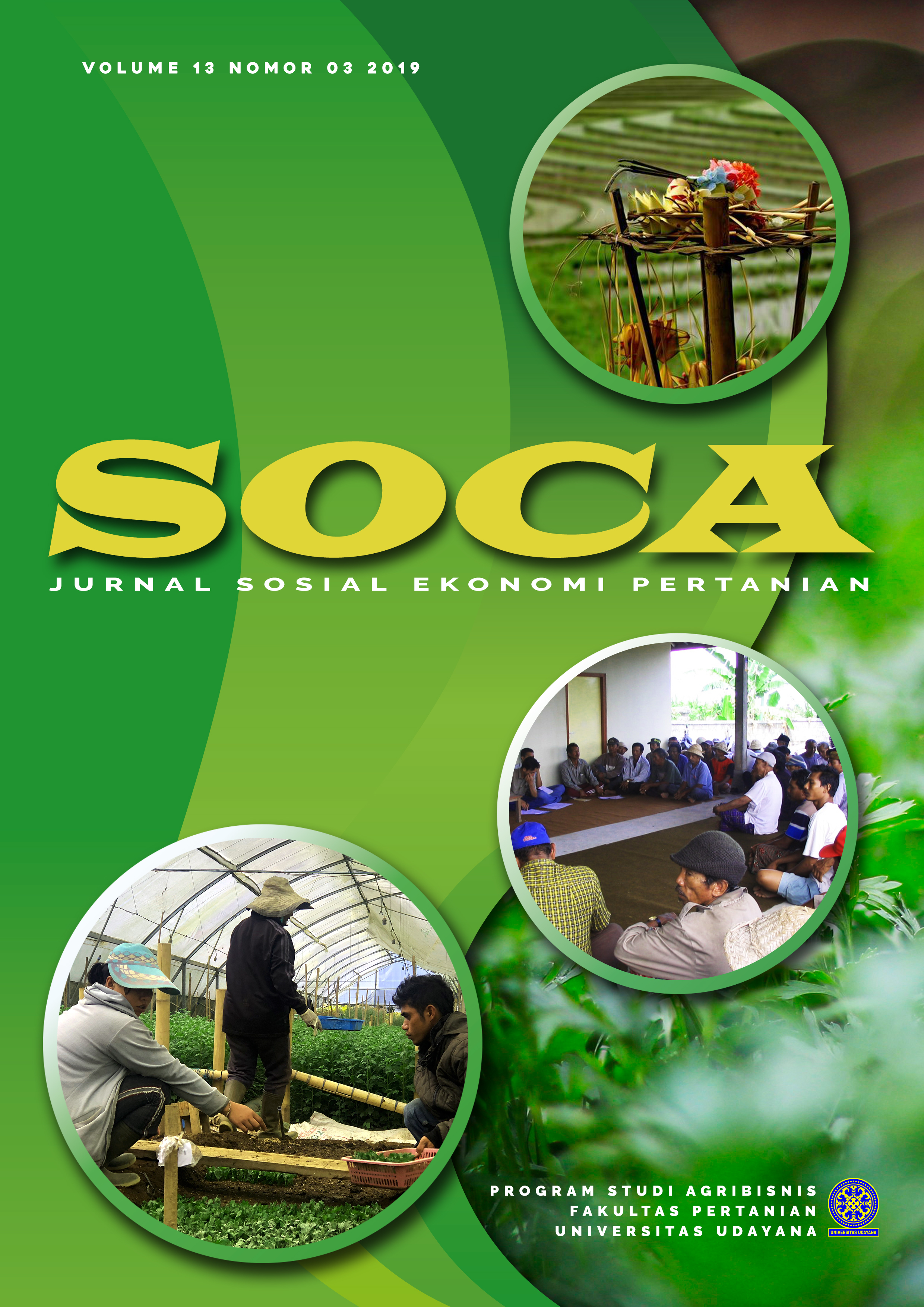PRODUK SAMPING TANAMAN UBIKAYU SEBAGAI POTENSI BIOEKONOMI UNTUK PERTANIAN MASA DEPAN
Abstract
Potential and opportunities for cassava development are still very broad along with development of companies in livestock, processed food, and other industries. Added value of cassava commodities resulting from development of downstream industries (processed products) is far higher than upstream industries (primary products), so that development paradigm in agriculture sector in future should be directed towards product expansion including its waste. This study aims to examine the economic value of cassava as a future crop from direct as well as by-products and their development strategies. Data was collected from small-scale tapioca flour farmers, ranchers and entrepreneurs. SWOT analysis was used to determine relevant development strategies. Analysis shows that cassava has an potential, especially as a raw material for food and feed industry. In short term, developing cassava strategy as an industrial raw material is to use new technologies i.e. varieties and cultivation techniques for planting arrangements. Cassava potential economic value is relatively high in terms of farming aspects, food raw materials, feed and industry. This potential, apart from main product, is also by-product that has been neglected at 29.7% of cassava main value. By-products potensial has not been used optimally and a bioeconomic value of biomass that can support integrated agriculture in the future.
Downloads
References
Damardjati, D. S. 2011. Menuju Industri Pertanian Bernilai Tambah dan Berorientasi Pasar. http://www.foodreview.biz/preview.php?view2&id=55720 . Download: 13 September 2011.
Eriyatno. 2003. Ilmu Sistem: Meningkatkan Mutu dan Efektivitas Managemen. IPB Press. Bogor.
Fauquet, C. 2016. The First World Congress on Root and Tuber Crops (Kongres Dunia Pertama tentang Tanaman Akar dan Umbi) yang berlangsung di Nanning, Guangxi, Tiongkok, 18-22 Januari 2016. Download: 27 Juli 2018.
Hartrisari. 2007. Sistem Dinamik. Konsep Sistem dan Pemodelan untuk Industri dan Lingkungan. Institut Pertanian Bogor. SEAMEO BIOTROP. Bogor.
Husodo S. 2006. Pangan dan Masa Depan Bangsa. Dalam: Ketut Puspanji, Wayan Rusastra, Dwi Praptomo, Sudi Mardianto, Suwaji, Dahlannudi, dan Wirajaswadi (Eds.). Pemasyarakatan Inovasi Teknologi Pertanian sebagai Penggerak Ketahanan Pangan Nasional. Balai Besar Pengkajian dan Pengembangan Pertanian Bogor.
Jarvis, A.; Ramirez-Villegas, J.; Campo, B.V.H. and Navarro, C. 2012. Is Cassava the Answer to African Climate Change Adaptation?. Available from: https://www.researchgate.net/publication/234076183_Is_Cassava_the_Answer_to_African_Climate_Change_Adaptation [accessed Jul 20 2018]. Article (PDF Available) in Tropical Plant Biology 5(1):9-29 · March 2012
Matthew, F. and Aung, M.T. 2018. Bioeconomy in Thailand: a case study. Stockholm Environment Institute. Stockholm Sweden.
Munasinghe, M. 1993. Environmental Economics and Sustainable Development. World Bank Environment Paper Number 3. The World Bank. Washington D.C.
Mupakati T and Vincent I. Tanyanyiwa. 2017. Cassava production as a climate change adaptation strategy in Chilonga Ward, Chiredzi District, Zimbabwe. Jamba. 2017; 9(1): 348.
Sunanto dan Nasrullah. 2012. Kajian Model Pertanian Zero Waste Dengan Pendekatan Sistem Integrasi Tanaman Jagung-Ternak Sapi di Sulawesi Selatan. Prosiding InsINas. http:insentif.ristek.go.id/PROSIDING2012/file-PG-Word_38.pd. Diunduh 3 Pebruari 2014.
Chuzaemi, S. 2002. Arah dan Sasaran Penelitian Nutrisi Sapi Potong Lokalit Sapi Potong. Puslitbang Peternakan. Bogor.
Kementan. 2013. Statistik Pertanian.
Pearce, D.W dan Turner, K. 1991. Economics of Natural Resources and The Environment Harvester Wheatsheaf.
Pearce, D.W dan D. Moran, 1994. The Economic Value of Biodiversity. IUNC. Earthscan Publication, London.
Pudjiastuti, A.Q.; Anindita, R.; Hanani, N.; Kaluge, D. 2013. Effects of Sugar Price Increase in Indonesia. Oeconomica. Vol. 58 Issue 1 pp. 28-39. Babes-Bolyai University.
Pudjiastuti, A.Q. 2014. Perubahan Neraca Perdagangan Indonesia sebagai Akibat Penghapusan Tarif Impor Gula. Agriekonomika. Vol. 3 No. 2 hal. 106-116. Universitas Trunojoyo Madura.
Pudjiastuti, A.Q. and Kembauw, E. 2018. Sugar Price Policy and Indonesia's Trade Balance. Journal of Advanced Research in Law and Economics. Vol. 8 Issue 30 pp. 2540-2548. Asers Publishing.
Rangkuti, F. 2001. Analisis SWOT: Teknik Membedah Kasus Bisnis. PT. Gramedia Pustaka Utama. Jakarta.
Rostini, T. and Biyatmoko, D. 2019. Performance of kacang goats fed with complete wafered forage based on Palm plantation waste. Pakistan Journal of Nutrition. Vol 18 No 6: 514-518.
Suci, D.H. 2007. Kebon Singkong Medco di Lampung (Reportase). Post info tanggal 19 November 2007. http://sucidh.wordpress.com/2007/11/19/kebon-singkong-medco-di-lampung/. Diunduh 3 Pebruari 2014.
Sunanto dan Nasrullah. 2012. Kajian Model Pertanian Zero Waste Dengan Pendekatan Sistem Integrasi Tanaman Jagung-Ternak Sapi di Sulawesi Selatan. Prosiding InsINas. http: insentif.ristek.go.id/PROSIDING2012/file-PG-Word_38.pd. Diunduh 3 Pebruari 2014.
Suparmoko dan Maria. 2000. Ekonomi Lingkungan. BPFE. Yogyakarta.













